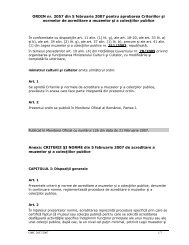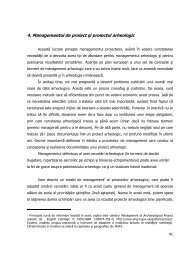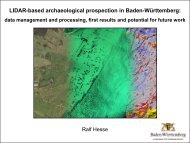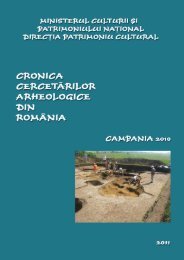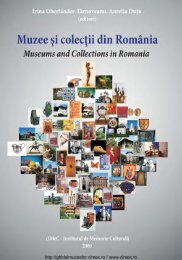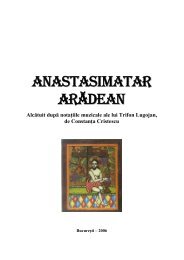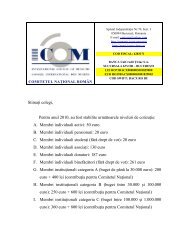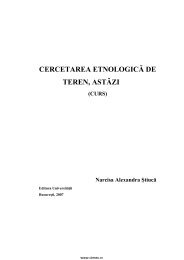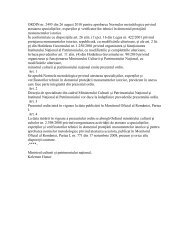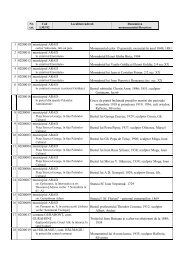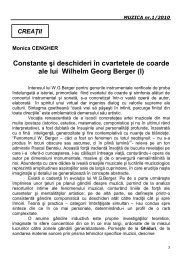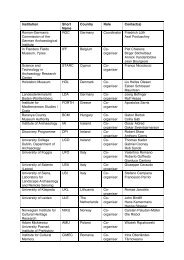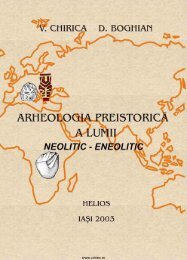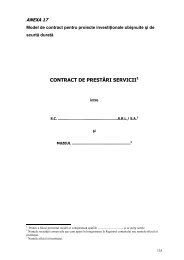Cronica-cercetarilor-arheologice-campania-2010 - cIMeC
Cronica-cercetarilor-arheologice-campania-2010 - cIMeC
Cronica-cercetarilor-arheologice-campania-2010 - cIMeC
You also want an ePaper? Increase the reach of your titles
YUMPU automatically turns print PDFs into web optimized ePapers that Google loves.
of the site and consisted in finishing section S6/2009, and<br />
opening a new one, S7/<strong>2010</strong>, of 2 x 30 m. In S6/2009 there<br />
were clearly observed the remnants of a house which continued<br />
in first 4 m from S 7/<strong>2010</strong>. Between the house remains we can<br />
remark one unburned brick and, for the first time, trace of a<br />
wooden beam, which was probably covered with clay.<br />
A second house was identified fragmentarily in<br />
S7/<strong>2010</strong>, between 20-24 m, from which parts of the clay floor<br />
were preserved. We were able to see on the floor surface traces<br />
of the tools used.<br />
The archaeological material consists in principal in<br />
pottery and metal objects (nails, two Roman keys and sickle),<br />
and domestic bone remains.<br />
41. Oltina, com. Oltina, jud. Constanța<br />
Punct: Capul Dealului<br />
Cod sit: 62495.01<br />
Autorizaţia de cercetare arheologică sistematică nr. 28/<strong>2010</strong><br />
Colectiv: Gabriel Custurea – responsabil, Cristina Talmaţchi,<br />
Constantin Şova (MINAC), Costel Chiriac, Dan Aparaschivei (IA<br />
Iaşi)<br />
Sectorul B<br />
Colectiv: Gabriel Custurea, Cristina Talmaţchi, Constantin Şova<br />
În anul <strong>2010</strong> săpătura sistematică din aşezarea<br />
fortificată de perioadă medieval timpurie de la „Capul Dealului” a<br />
fost concentrată asupra complexului 1/2008, din SIB, pentru a<br />
cărui decopertare integrală s-a procedat la realizarea unei<br />
casete, Cas. A/<strong>2010</strong>, în c.19-24, de 5,5 x 2,5 m.<br />
Complexul, de forma unui patrulater, are laturile de<br />
3,82 m (N), 3,70 m (S), 3,30 m (V), respectiv de 3,15 m (E).<br />
Este o locuinţă semi-adâncită, care avea, pe o înălţime de 0,45<br />
m, pereţii căptuşiţi cu lemn. În colţuri se păstrează urma stâlpilor<br />
de lemn sau chiar resturi carbonizate ale acestora, care<br />
susţineau pereţii din partea superioară şi acoperişul. Podeaua a<br />
fost realizată din lipitură de lut galben, iar în colţul de NE se<br />
păstra vatra deschisă (0,90 x 0,74 m), sub forma unui pat de<br />
piatră delimitat în partea de sud de un prag din lipitură de<br />
pământ galben, acum copt, mai înălţat în colţul de SV şi rotunjit.<br />
În faţa acesteia se afla intrarea în locuinţă. Faţă de nivelul<br />
actual de călcare, podeaua se află la – 0,48/- 0,75 m, diferenţa<br />
fiind dată de panta terenului. Locuinţa a fost incendiată, pe<br />
suprafaţa acesteia fiind descoperite numeroase bucăţi de lemn<br />
ars. Inventarul complexului constă în ceramică fragmentară şi<br />
un vas spart aflat chiar pe podea, un mâner de corn într-o stare<br />
de conservare precară şi un obiect fragmentar de os decorat cu<br />
cercuri concentrice, perforat la capătul păstrat.<br />
În c.30-32 a apărut, la –0,56 m, groapa unui mormânt<br />
fără schelet, cu orientarea V - E. Aceasta era marcată în partea<br />
superioară de un şir de pietre, iar în interior păstra urma<br />
sicriului-ladă, resturi carbonizate ale acestuia aflându-se în<br />
părţile superioară şi inferioară şi în unele zone laterale pe toată<br />
lungimea gropii. Mormântul avea 2,05 m pe interiorul şirului de<br />
pietre, iar lăţimea de 0,90 m. Acesta se opreşte la -0,95 m faţă<br />
de actualul nivel de călcare, pe lutuiala unui bordei, care are în<br />
inventar ceramică medieval-timpurie, printre care şi un vas<br />
fragmentar cu marcă. În interior, în zona în care ar fi trebuit să<br />
se afle oasele picioarelor erau câteva oase de animale.<br />
<strong>Cronica</strong> cercetărilor <strong>arheologice</strong> din România – <strong>campania</strong> <strong>2010</strong><br />
93<br />
Pe ansamblu, materialul arheologic descoperit constă<br />
în ceramică fragmentară (sec. X-XII), arsă oxidant şi reducător<br />
(printre care şi fragmente de cazan peceneg), fusaiole, oase,<br />
obiecte din fier etc. În stratul vegetal au apărut şi fragmente<br />
ceramice specifice sec. IV-VII.<br />
Materialul rezultat a fost depozitat la MINA Constanţa.<br />
Abstract<br />
In <strong>2010</strong> the systematic digging in the early medieval<br />
fortified settlement from ‘Capul Dealului’ has been concentrated<br />
upon the Complex 1/2008, from S I B, for which there has been<br />
made a box, Cas. A/<strong>2010</strong>, in c.19 – 24, of 5.5 x 2.5 m, in order<br />
to be totally uncovered.<br />
The quadrilateral shaped complex has the sides of<br />
3.82 m (N), 3.70 m (S), 3.30 m (V), and 3.15 m (E). It is a semideepen<br />
house, having boarded walls on 0.45 heights. In the<br />
corners there are preserved traces of wood poles or even burnt<br />
remains of these, supporting the upper walls and the roof. The<br />
floor was made of yellow clay, and in the NE corner there is was<br />
preserved the open fireplace (0.90 x 0.74 m), as a stone bed<br />
limited on the south side by a yellow clay threshold, now burnt,<br />
higher in the SV corner and rounded. The house entrance was<br />
in front of it. Compared to the actual stepping level, the floor is<br />
situated at – 0.48/ - 0.75 m. The difference is coming from the<br />
ground slope. The complex inventory includes fragmentary<br />
pottery and a broken pot situated even on the floor, a poorly<br />
preserved horn handle and a fragmentary bone object<br />
decorated with concentric circles, punched on the preserved<br />
end.<br />
In c.30 – 32 there emerged, at – 0.56 m, a tomb<br />
without skeleton, oriented west-east. The tomb was 2.05 m<br />
inside the stone row, and it was 0.90 m width. This is situated at<br />
– 0.95 m compared to the actual stepping level, on a hut floor.<br />
As a general view, the archaeological material<br />
includes fragmentary pottery (10th - 12th centuries), spindle<br />
weights, bones, iron objects etc. There emerged also in the<br />
vegetal stratum fragmentary pottery specific to the 4th - 7th centuries.<br />
The material has been stored at the Museum of<br />
National History and Archaeology in Constanţa.<br />
42. Ostrov, com. Ostrov, jud. Constanţa<br />
[Durostorum]<br />
Punct: Ferma 4<br />
Cod sit: 62547.01<br />
Autorizaţia de cercetare arheologică sistematică 86/<strong>2010</strong><br />
Colectiv: Crişan Muşeţeanu - responsabil, Paul Damian, Adela<br />
Bâltâc, Virgil Apostol, Eugen Paraschiv-Grigore, Ioana<br />
Paraschiv-Grigore (MNIR), Dragomira Boeva-Kanceva (MDJ<br />
Călărași)<br />
În <strong>campania</strong> <strong>2010</strong> 1 au continuat cercetările în Sectorul I<br />
Thermae, având ca obiective principale surprinderea unor detalii<br />
constructive legate de cele două edificii identificate aici, mai<br />
ales privind limita de E a edificiului termal şi limita de N a<br />
edificiului nr. 3. Cercetarea s-a efectuat, astfel, în unele<br />
suprafeţe deschise în anii anteriori în zona de E a sitului (C17,<br />
C19–20), precum şi prin demontarea unui martor stratigrafic<br />
dintre suprafeţele C8 şi C20.<br />
Edificiul termal 2




